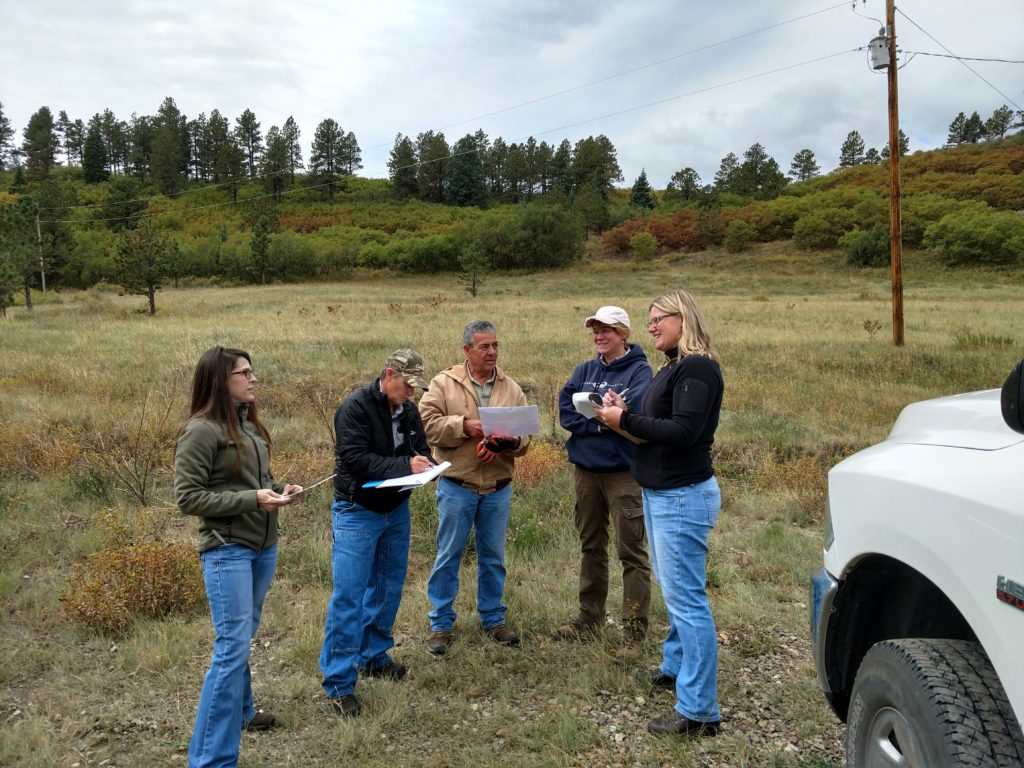Here is a quick look at some of the on-the-ground projects we are working on around the watershed!
River Restoration Projects for Improved Ecological Health & Functionality

We work together with local and regional partners to conduct strategic on-the-ground projects to improve the ecological health and functionality of our river. Through a recently completed Purgatoire River Assessment effort, and a new Stream Management Planning effort that is underway, we are working with local and regional experts and stakeholders from across the watershed to pinpoint (among other things) where our ecological conservation and restoration needs are the greatest along the river, and develop and prioritize on-the-ground projects to address these needs.
On-the-Ground Stewardship Volunteer Work

We recently established the Purgatoire Watershed Outdoor Stewardship Program, an exciting new program that supports on-the-ground volunteer stewardship activities like river cleanups, riparian corridor restoration, and small-scale trail building and other recreational improvements. This Stewardship Program also provides a host of relevant education and skills training opportunities for participating volunteers to support their personal/career growth as well as directly benefit our watershed!
In-Stream Fish Habitat Enhancement & Fishery Development

We work closely with our local Trout Unlimited Chapter – Purgatoire River Anglers – to support in-stream habitat improvements and improved fish passage for native and sport fish, and support continued development of the local recreational fishery. We are also very excited about our Youth Outdoor Education Series (now in its second year!) that gets local kids outdoors and playing in their river while learning about fish biology & ecology, how they can help restore & protect fish habitat, the skills & ethics of fishing, and experience what its like to release a young trout into its new home!
Fire Mitigation & Forest Health Projects

In the upper watershed we are working with local and regional partners to support on-the-ground fire mitigation/forest thinning work, related monitoring work, and other important forest restoration activities to reduce the threat of catastrophic fire in our watershed and improve overall forest health.
Invasive Species Management

Our local sister organization – Purgatoire Watershed Weed Management Collaborative (PWWMC) – spearheads invasive vegetation management & related education efforts in our watershed. We frequently partner with PWWMC and look to them to provide us with their expertise and resources on a variety of projects in the watershed that involve invasive vegetation management and related education efforts. Check out PWWMC to learn how they can help you manage weed infestations on your property! We also work closely with our incredible Purgatoire River Vegetation Management Crew volunteers and Mile High Youth Corps to remove a lot of woody invasive vegetation along our river.
We also strongly support CPW’s work to prevent other invasive species such as Aquatic Nuisance Species (ANS) – like zebra and quagga mussels – from infecting our waterways.
Agricultural Infrastructure Improvements

We are currently working closely with another local organization – Purgatoire River Water Conservancy District (PRWCD) – and local irrigators to assess irrigation infrastructure needs on the river and develop collaborative on-the-ground projects that not only benefit local agriculture but also provide added ecological, recreational, and/or economic benefits.
Urban Wildlife Corridor Habitat Improvements & Wildlife Viewing

As the Purgatoire River winds its way through the ‘urban center’ of our watershed – downtown Trinidad, CO – we are lucky enough to still maintain a relatively healthy wildlife corridor supporting a wide variety of native species. An exciting mix of birds and other wildlife utilize this urban corridor on a year-round basis or temporarily as they migrate between our upper and lower watershed, or from north to south. We are working hard to continue to improve the habitat in this area and provide more opportunities for wildlife education and viewing!
Recreational & Educational Enhancements Along the River

These are exciting times in our watershed with ever increasing recreational opportunities for community members and tourists, and we work to support our local partners who are spearheading a lot of these efforts (e.g. Fishers Peak & Trinidad Lake State Parks, USACE, USFS, Trout Unlimited, Trinidad State College, City of Trinidad, Trinidad Trails, Backshop Bikes). In particular, we work closely with City of Trinidad, Trout Unlimited, and other partners on recreational and educational enhancements (e.g. small trail building, improved river access for fishing and playing, educational signage, wildlife viewing stations) along the Trinidad Riverwalk – a local expanding river trail system providing increasing opportunities for enjoyment of and access to the river through downtown Trinidad.
Ecological Scientific Assessment, Monitoring & Data Collection

We work with local and regional scientific experts as well as community volunteers to conduct field monitoring and assessment efforts and collect important ecological data for determining the current status of our river and watershed, tracking progress, and planning on-the-ground projects to protect important resources and/or improve the ecological health of our river where we are falling short. We recently completed an exciting Purgatoire River Assessment effort, and are working to expand our community volunteer Citizen Scientist program that focuses on activities such as collecting water quality samples through our River Watch effort, conducting pre- and post- restoration monitoring, and other important data collection efforts.
Jetty Jack Removal/Mitigation

We are currently working closely with USACE, City of Trinidad, and other local partners on developing a mutually acceptable plan for strategic removal/mitigation of the flood-protection structures known as ‘jetty jacks’. These large, inter-connected iron structures were installed many years ago for river-bank protection/stabilization after several large flooding events significantly impacted the area. Trinidad Dam was later constructed, which has significantly reduced the threat of large-scale flooding on downstream communities. While the threat of large-scale flooding can never be completely eliminated, these old jetty jack structures are now failing in multiple locations, and present a significant safety and liability hazard throughout the river corridor (as well as being a local eye-sore). A new strategy is needed to better stabilize the river banks against flooding where it is needed, while improving river safety and aesthetics.

